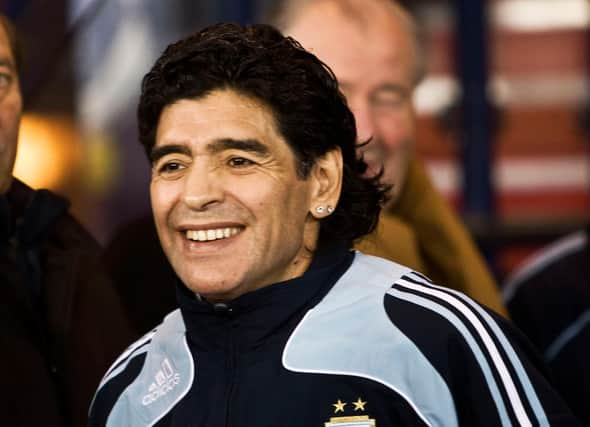Diego Maradona: Adored in Argentina, immortal in Italy, special in Scotland


Diego Armando Maradona’s death at the age of 60 unites the footballing community from Barcelona to La Boca and all points in between. This isn’t just a legend, this is the man who took his chosen sport to new heights of expertise.
He suffered a cardiac arrest in the San Andrés neighbourhood of Argentina’s capital shortly before 12pm local time on Wednesday. Doctors tried to resuscitate a World Cup-winning captain who had undergone brain surgery just three weeks ago, but to no avail.
Advertisement
Hide AdAdvertisement
Hide AdMaradona’s family said he seemed anxious and nervous in recent days so they considered transferring him to Cuba to continue rehabilitation. They were denied the opportunity. Now the world is left with only grainy footage of his undoubted genius, something we will never tire of watching.
Early impression in Scotland
Some of the best was captured at Hampden Park in 1979. Argentina first capped Maradona aged 16 and brought him to Glasgow for a friendly as an 18-year-old prodigy.
He scored his first international goal and teed up Leopoldo Luque for another as Scotland lost 3-1. Most of the 62,000 crowd left Mount Florida chattering about the teenager who had rampaged around all afternoon.
The Hand of God replays and the rasping Serie A goals with Napoli tell only half the story of ‘El Diego’. Drugs like cocaine heavily influenced, not to mention damaged, his life. He also became an associate of The Camorra, an Italian mafia, during his time there.
A rapid rise
Maradona grew up in Villa Fiorito, a shanty town in the south of Buenos Aires, yet achieved unrivalled fame by inspiring Argentina’s World Cup triumph at Mexico 86. In doing so, he became an idol among many Scottish supporters for two unforgettable goals against England.
He emerged at Argentinos Juniors as a kid of whom many coaches were in awe. They granted him a professional debut ten days before his 16th birthday. Five years later, after 116 goals in 167 games, he joined Boca Juniors.
A season later he headed for Europe, becoming the world’s most expensive player in a £5million move to Barcelona. He did not make the desired impression and moved on to Napoli in 1984.
Neapolitan folklore
This period of his career is perfectly captured by Asif Kapadia’s 2019 film Diego Maradona. His arrival at the Stadio San Paolo saw fans fill the ground to welcome their new hero.
Advertisement
Hide AdAdvertisement
Hide AdOne local newspaper wrote that “despite the lack of a mayor, houses, schools, buses, employment and sanitation, none of this matters because we have Maradona”.
The anticipation was well-justified as Napoli entered the greatest period in their history – two Serie A titles, a UEFA Cup and a Coppa Italia etched Maradona’s name in Neapolitan folklore.
Many want to remember him as he was in June 1986: Thighs like treetrunks bursting through black Le Coq Sportif shorts, the black curly hair, feet quicker than the Road Runner, and of course the sky blue and white stripes.
Global stage and Hand of God
Maradona’s performances at the World Cup in Mexico are among the greatest ever seen in football. At just 5ft 5ins tall, the sight of this diminutive South American dancing past the best on the planet like they weren’t even there was overwhelming.
Argentinians worshipped his ability but also adored his dirty side; being a streetwise urban kid enhanced his appeal. Never more so than against England in the World Cup quarter-final.
The famous Hand of God brought much amusement in Scotland but Maradona’s second goal on that boiling afternoon in the Estadio Azteca was voted FIFA’s Goal of the Century.
He dribbled from the centre circle past five English opponents and goalkeeper Peter Shilton before prodding the ball into the net. As the famous Uruguayan commentator Victor Hugo Morales narrated at the time: “Genio, genio, genio.”
Like most Maradona goals, this was followed by the obligatory scream: “Goooooooooaaaaaaaaaallllll!” He played in four World Cups, however Mexico was the pinnacle in so many ways.
Life after playing
Advertisement
Hide AdAdvertisement
Hide AdHe moved into management without any real success but did take charge of Argentina for two years. His tenure as national coach kicked off in November 2008 with a return to Hampden, where he had impressed so many as a teenager all those years previously.
It was obvious that day in 1979 that Argentina had unearthed someone extraordinary. The dodgy footage still exists if you search on Youtube. Subsequent years only served to prove the theory, but nothing will ever compare to 1986.
As Michael Caine said in Hero: The Official Film of the 1986 World Cup: “There are some athletes so gifted, so commanding, that they can lift a team – even an entire sport – to an extraordinary level of accomplishment. Sometimes they carry a whole nation. Diego Armando Maradona is such an athlete.”